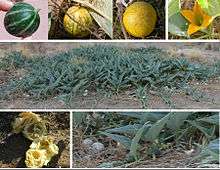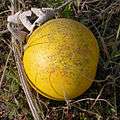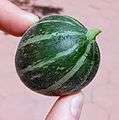Cucurbita foetidissima
| Cucurbita foetidissima | |
|---|---|
 | |
| Buffalo gourd plant, male flower and fruits. | |
| Scientific classification | |
| Kingdom: | Plantae |
| Clade: | Angiosperms |
| Clade: | Eudicots |
| Clade: | Rosids |
| Order: | Cucurbitales |
| Family: | Cucurbitaceae |
| Genus: | Cucurbita |
| Species: | C. foetidissima |
| Binomial name | |
| Cucurbita foetidissima Kunth in Humb.[1] | |
| Synonyms[2] | |
Cucurbita foetidissima is a tuberous xerophytic plant found in the central and southwestern United States and northern Mexico.[3] It has numerous common names, including: buffalo gourd,[1] calabazilla,[1] chilicote, coyote gourd, fetid gourd, fetid wild pumpkin,[1] Missouri gourd,[1] prairie gourd,[4] stinking gourd, wild gourd,[1] and wild pumpkin.[1] The type specimen was collected from Mexico by Humboldt and Bonpland sometime before 1817.[1]
The feral perennial buffalo gourd has evolved in the semiarid regions and is well-adapted to desert environments. It contains high amounts of protein and carbohydrates and yields abundant oil.[5] The carbohydrates that are formed in the tap root have led to the idea of growing the plant for biofuel.[6][7]
The fruit is consumed by both humans and animals. When mature, a stage marked by increasing desiccation of vine, leaves, fruit-stem, and fruit, the fruit begins its final gourd stage.
Geographic location and genetics make it highly likely that Cucurbita scabridifolia originated as a naturally occurring hybrid of C. foetidissima and Cucurbita pedatifolia.[8]
| Wikimedia Commons has media related to Cucurbita foetidissima. |
Morphology and cultivation
Cucurbita foetidissima requires little water and grows best in semiarid and arid environments.[9] Warm weather is required during the five- to eight-month vegetation period.[5][10] This perennial is well adapted to marginal agricultural lands such as sandy loam soils which have to be well-drained.[10][11] Germination temperature range is between 15 °C and 37 °C with an optimum at 25 °C.[12]
The maximum depth for a successful germination is 12 cm.[12] The germination is possible in a pH range from 2.2 (germination rate 15% ) up to pH 8 (germination rate 90%).[12] Asexual propagation is possible from nodal roots.[10]
The leaves of the buffalo gourd are typically entire and heart-shaped with a base of 10–13 cm (4–5 in) and length of 20–25 cm (8–10 in). The flowers are borne singly at the nodes of the vines after a certain amount of annual vegetative growth has taken place.[5]
The fruit has a diameter of 7–10 cm (3–4 in).[12] The fruit weighs 120 g to 150 g, with 292 to 315 seeds per fruit.[5] The seeds, which are 12 mm (0.5 in) long and 7 mm (0.3 in) wide, weigh about 4 g per 100 seeds,[10] with the seed coat accounting for about 30% of the seed weight.[5] The seeds often remain viable for months or even years within an undamaged gourd.[5] One hectare of plants can produce 2.5 tons of seed.[10]
The plant forms a fleshy tap root which is used as a storage and overwintering structure.[12] The central tap root can weigh up to 72 kg (159 lb). A four-year-old root grown under cultivation can reach a fresh weight of 45 kg (99 lb) and a length of 2.5 m (8.2 ft).[5]
Distribution
Cucurbita foetidissima is native to North America in the central and southwestern United States (Arizona; Arkansas; southern California; Colorado; Kansas; Missouri; southern Nebraska; southern Nevada, New Mexico; Oklahoma; Texas; and southern Utah) and Mexico (Aguascalientes; Chihuahua; Coahuila; Guanajuato; Guerrero; Hidalgo; northern Jalisco; Mexico; Nuevo León; Querétaro; San Luis Potosí; Sonora; Tamaulipas; and Zacatecas).[4][13][14]
Uses
The buffalo gourd has the potential of being a crop adapted to arid to semiarid lands.[5]
- Fresh gourd: The fresh young gourd can be eaten like squash. The mature fruit is no longer edible, due to bitter compounds.
- Seeds: Eaten after being prepared by roasting or boiling.[15]
- Oil: The extractable oil content in whole seeds reaches from 24.3%[5] to 50%.[9] Linoleic acid, an essential polyunsaturated fatty acid, comprises 38% to 65% of the oil.[5] A characterization of the oils from buffalo gourd indicates that this oil is similar to other common edible oils.[16]
- Protein: Whole Buffalo gourd seeds contain approximately 31% crude protein, which is usable for human consumption and for feed.
- Starch: Is mainly located in the tap root which forms after the first year of growth. The starch content in the dried root is between 47.5%[11] and 56%.[5]
- Fodder: Fresh leaves or the whole plants can be used as animal food.
- Biofuel: Biodiesel can be produced from the oil in the seeds.[17] But the main interest to produce renewable fuels is to produce biofuel with the carbohydrates which are located in the tap root.
- Other uses: In many Native American cultures, the fruit and other parts of the plant, buffalo gourd oil, were used for soap.[18] Furthermore, the protein can be used for industrial purposes (water paints, paper coating, adhesives and textile sizing).[5][10] The Zuni people use a poultice of powdered seeds, flowers and saliva for swellings.[19]
C. foetidissima contains a saponin that can be obtained from the fruit and root. This can be used as a soap, shampoo, and bleach. Prolonged contact can cause skin irritation.[20][21]
Pests
Various insects may penetrate the hard skin of the gourd. External structures appear to prevent damage by most insects and the plant is highly resistant to cucumber beetle and squash bug.[10] White molds seem to result in smooth surface areas and black molds often form circular patterns.
Gallery
 Staminate (male) flower
Staminate (male) flower- Mature Cucurbita foetidissima fruit (Austin, Texas).
 Mature fruit
Mature fruit Interior view (Newport Beach Back Bay, California).
Interior view (Newport Beach Back Bay, California). Buffalo gourds in Puente Hills.
Buffalo gourds in Puente Hills.- Buffalo gourd in Albuquerque, New Mexico.
 Buffalo gourd, close up photo, Albuquerque, New Mexico.
Buffalo gourd, close up photo, Albuquerque, New Mexico.
References
- 1 2 3 4 5 6 7 8 "Name - Cucurbita foetidissima Kunth". Tropicos. Saint Louis, Missouri: Missouri Botanical Garden. Retrieved December 11, 2012. Cucurbita foetidissima was originally described and published in Nova Genera et Species Plantarum (quarto ed.) 2: 123. 1817.
- ↑ "TPL, treatment of Cucurbita foetidissima Kunth". The Plant List; Version 1. (published on the internet). Royal Botanic Gardens, Kew and Missouri Botanical Garden. 2010. Retrieved December 11, 2012.
- ↑ Bemis, W. P.; Whitaker, Thomas W. (April 1969). "The Xerophytic Cucurbita of Northwestern Mexico and Southwestern United States". Madroño. California Botanical Society. 20 (2): 33–41. JSTOR 41423342.
- 1 2 GRIN (February 12, 2010). "Cucurbita foetidissima information from NPGS/GRIN". Taxonomy for Plants. National Germplasm Resources Laboratory, Beltsville, Maryland: USDA, ARS, National Genetic Resources Program. Retrieved December 11, 2012.
- 1 2 3 4 5 6 7 8 9 10 11 12 Bemis, J.; Curtis, L.; Weber, C.; Berry, J. (1978). "The Feral Buffalo Gourd, Cucurbita foetidissima". Economic Botany. 32: 87–95. doi:10.1007/bf02906733.
- ↑ Smeal, D. (1997). "Carbohydrate biofuels. III. Consumptive-use and root yield of buffalo gourd (Cucurbita foetidissima HBK)". Fuel and Energy Abstracts. 38 (5): 325. doi:10.1016/S0140-6701(97)81177-0. Retrieved August 22, 2008.
- ↑ Blume, David (2007). Alcohol Can Be a Gas! Fueling an Ethanol Revolution for the 21st Century. The International Institute For Ecological Agriculture.
- ↑ Andres, Thomas C. (1987). "Relationship of Cucurbita scabridifolia to C. foetidissima and C. pedatifolia: A Case of Natural Interspecific Hybridization". Cucurbit Genetics Cooperative Report. Raleigh, NC: North Carolina State University. 10: 74–75.
- 1 2 Berry, J.; Bemis, J.; Weber, C.; Philip, T. (1975). "Cucurbit Root Starches: Isolation and Some Properties of Starches from Cucurbita foetidissima HBK and Cucurbita digital". Journal of Agricultural and Food Chemistry. 23 (4): 825–826. PMID 1141535. doi:10.1021/jf60200a020.
- 1 2 3 4 5 6 7 Bemis, J. (1975). Underexploited Tropical Plants with Promising Economic Value. National Research Council. pp. 94–99. ISBN 978-0-89499-186-8.
- 1 2 Nelson, J.; Scheerens, J.; Bucks, D.; Berry, J. (1989). "Irrigation Effects on Water Use, and Production of Tap Roots and Starch of Buffalo Gourd". Agronomy Journal. 81 (3): 439–442. doi:10.2134/agronj1989.00021962008100030008x.
- 1 2 3 4 5 Horak, M.; Sweat, J. (1994). "Germination, Emergence, and Seedling Establishment of Buffalo Gourd (Cucurbita foetidissima)". Weed Science Society of America. 42: 358–363.
- ↑ Biota of North America Program 2014 county distribution map
- ↑ SEINet, Southwestern Biodiversity, Arizona chapter
- ↑ Cutler, Hugh C.; Whitaker, Thomas W. (1961-01-01). "History and Distribution of the Cultivated Cucurbits in the Americas". American Antiquity. 26 (4): 469–485. doi:10.2307/278735.
- ↑ Vasconcellos, J.; Berry, J.; J. Bemis, C. Weber; Scheerens, J. (1980). "The properties of Cucurbita foetidissima seed oil". Journal of the American Oil Chemists Society. 57 (9): 310–313. doi:10.1007/bf02662214.
- ↑ Kurki, A.; Hill, A. (2006). "Biodiesel: The Sustainability Dimensions". ATTRA. 3: 458–467.
- ↑ Lowell J. Bean and Katherine Siva Saubel (1972). Temalpakh: Cahuilla Indian Knowledge and Usage of Plants. Malki Museum Press, Morongo Indian Reservation. p. 57.
- ↑ Camazine, Scott; Bye, Robert A. (1980). "A Study Of The Medical Ethnobotany Of The Zuni Indians of New Mexico". Journal of Ethnopharmacology. 2 (4): 365–388. PMID 6893476. doi:10.1016/s0378-8741(80)81017-8. (p. 375)
- ↑ Cutler, H.C.; Whitaker, T.W. (1961). "History and Distribution of the Cultivated Cucurbits in the Americas". American Antiquity. 26 (4): 469–485. JSTOR 278735. doi:10.2307/278735.(subscription required)
- ↑ Heiser, Charles B. (2016). "The Gourd Book". Norman, OK: University of Oklahoma Press: 9, 33–34. ASIN B01BG937P8. ISBN 0806155671.
